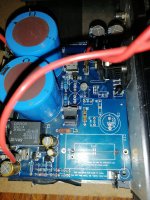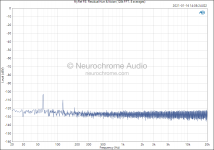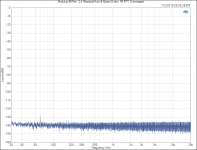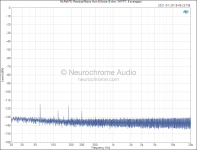I'm sure that your specimen measured that way, no problem about that.The MyRef FE produces 69 µV of white noise at its output.
I'm sure it is but just for clarity, this measure was made with shorted input?
This is where my (and others) experience differs, as previously said.I can hear this with my relatively inefficient bookshelf speakers as hiss from the tweeters. I hear this when I have my head within 30 cm of the speakers.
I can hear the hiss from 10 cm of a 90dB speaker.
No, obviously, it's exacly for this reason that I've proposed to test another noise source at 69uV or even a sine wave at 69uV, you should hear both the noise source and the My_Ref noise at the same manner.Unless you believe that 69 µV of white noise from the MyRef FE is somehow different from 69 µV of white noise from another noise source, my speakers will produce the same SPL with the two sources.
If not maybe there is another problem.
Can the FE be improved? Obviously!
And will probably do in its evolution but what is important is that the amp is not 'broken' for this reason, someone could read your technical critique in this way but it's not the case.
Yep. I always measure the noise of an amp with its inputs shorted.
Perfect, tnx
So, here I would like to show the noise test result of my personal Myref FE, with a moderate BOM setup, and my preferred 'standard' Fet input opamp (OPA828) configuration.
The load is 7ohm, the input is shorted, the bandwith of the scope is set to 20kHz, and the AC RMS measurement is turned on.
First screen is the scope baseline measurement, with (scope) input shortened. Readout: 10,77uV AC RMS.
The second screen is the actual measurement, with the FE amp on, input shorted, scope at 500uV/div max resolution. Readout: 45,2uV.
The readout is the quadratic sum of the scope noise + real noise contribution of the amp. After quadtatic subtraction the FE contribution is sqrt(45,2^2-10.77^2)= 43,8uV.
Plus, this is not a proper steep wall noise filter, so it could be a bit even less. But let's take it for good, so this is 43,8uV total /31,6 gain = 1,4uV input referred noise.
As mentioned before, of this total a great part is from the input series RF filter resistance, 3,3kohm thermal noise. That adds like 0.65 uV input referred noise to the gain structure's inherent noise.
The load is 7ohm, the input is shorted, the bandwith of the scope is set to 20kHz, and the AC RMS measurement is turned on.
First screen is the scope baseline measurement, with (scope) input shortened. Readout: 10,77uV AC RMS.
The second screen is the actual measurement, with the FE amp on, input shorted, scope at 500uV/div max resolution. Readout: 45,2uV.
The readout is the quadratic sum of the scope noise + real noise contribution of the amp. After quadtatic subtraction the FE contribution is sqrt(45,2^2-10.77^2)= 43,8uV.
Plus, this is not a proper steep wall noise filter, so it could be a bit even less. But let's take it for good, so this is 43,8uV total /31,6 gain = 1,4uV input referred noise.
As mentioned before, of this total a great part is from the input series RF filter resistance, 3,3kohm thermal noise. That adds like 0.65 uV input referred noise to the gain structure's inherent noise.
Attachments
Last edited:
Wished to add that it was taken from a full, operational, daily use amp, equipped with a 300VA Talema toroidal /channel. On an MDF board, no chassis & screening.
Why am I showing it? Because the modul what Tom has measured, was given to him 3? 4? Years ago. In the meantime some other options, configurations has stabilized in the community. The FET opamp option became part properly in this present, active last group buy.
Again: I am not doubting Tom's result. That was taken with the original LM318 control opamp in the composite structure. That result still could be valid for a module with classic BOM.
I will measure also that, but right now I don't have one assembled with LM318..
Ciao, George
Why am I showing it? Because the modul what Tom has measured, was given to him 3? 4? Years ago. In the meantime some other options, configurations has stabilized in the community. The FET opamp option became part properly in this present, active last group buy.
Again: I am not doubting Tom's result. That was taken with the original LM318 control opamp in the composite structure. That result still could be valid for a module with classic BOM.
I will measure also that, but right now I don't have one assembled with LM318..
Ciao, George
Last edited:
My hearing maybe suspect. I cannot hear noise from a FE 13th GB with ear in the tweeter or midrange horns on a 105 dB efficient speaker.
This is with a Focusrite Clarett 4Pre connected. Just turning the digital volume control down on the interface. Using the LM318.
I was using a 10 year old dac for a while to utilize DRC. It was audible. Not the amplifier. Grainy noise, assume the dac was just noisey.
A Micromega MyAmp is also silent at any gain level with the 4Pre. Dead quiet should be achievable. At least to my ears.
This is with a Focusrite Clarett 4Pre connected. Just turning the digital volume control down on the interface. Using the LM318.
I was using a 10 year old dac for a while to utilize DRC. It was audible. Not the amplifier. Grainy noise, assume the dac was just noisey.
A Micromega MyAmp is also silent at any gain level with the 4Pre. Dead quiet should be achievable. At least to my ears.
I have never heard hiss from tweeters of a wide range of speakers with any configuration of MyRef that I've built.
Let's not forget that Tom has a product to sell. As diligent as he may have been with his construction, set-up, and measurements, there is a bias present. Did anyone doubt his conclusion would be that his amps measure better?
I wonder if he built both and took the time to actually listen to them. Or is that type of test too subjective?
Peace,
Tom E
Let's not forget that Tom has a product to sell. As diligent as he may have been with his construction, set-up, and measurements, there is a bias present. Did anyone doubt his conclusion would be that his amps measure better?
I wonder if he built both and took the time to actually listen to them. Or is that type of test too subjective?
Peace,
Tom E
Yes, I forgot to add: in my system, there is no way to tell if it is ON. Dead silence emanates into the room. I used to have a faint hum, which I used to use as a reality control, if I still capable to hear it. That hum originates in one of my Metcal stations, if I forget to switch it off...
Let's not forget that Tom has a product to sell. As diligent as he may have been with his construction, set-up, and measurements, there is a bias present. Did anyone doubt his conclusion would be that his amps measure better?
You can read the graphs and come to you own conclusions and make a decision. What seems more obvious is YOUR bias on this as you find it hard to accept the measurement. The take away for me is the importance of getting your gain structure correct to minimise noise in the system. This is always a very useful thing to take into account as a lot of people get this badly wrong and do end up with a noisy system.
A subjective opinion is, IMO, of little use. Measurements are useful and show the important things. It also shows where improvments might be made (which may or may not be audible). So this is good. There is data where there was none and everyone should be happy about that.I wonder if he built both and took the time to actually listen to them. Or is that type of test too subjective?
For the record, my take away is that both should be transparent and I would be happy with either. But that is my view and therefore should be ignored in decision making.
Let's not forget that Tom has a product to sell. As diligent as he may have been with his construction, set-up, and measurements, there is a bias present. Did anyone doubt his conclusion would be that his amps measure better?
While an unconscious bias is absolutely possible, we're humans after all, I don't think Tom has made or stated anything on purpose.
Measurements speaks for themelves (for the good and the bad) and I'm sure Tom actually heard that noise, I would have liked further investigations about it since builders don't have this problem but I understand that it could be out of scope for his commitment when we agreed to measure the My_Ref FE.
Let's not forget that Tom has a product to sell. As diligent as he may have been with his construction, set-up, and measurements, there is a bias present.
True. I am human.
I would welcome it if you would back up your claim of bias with a plausible explanation for how a calibrated Audio Precision APx525 can be biased in its measurements.
You can certainly claim that I'm biased in my writeup or conclusions, but nothing prevents you from ignoring the text and just looking at the measurements.
I wonder if he built both and took the time to actually listen to them. Or is that type of test too subjective?
I did listen to the MyRef FE. Aside from the hiss from the tweeters, that I found audible within 30 cm of the speakers, I have no comments on it. You can interpret this any way you wish.
I did consider writing a blurb about my listening experience, but such a blurb would be guaranteed to be biased. Even if I claimed that I did my best to avoid bias (yeah, right!), had friends over who supported my conclusions (look up Asch's conformity studies from the 1950s if you believe such a claim would be scientifically valid), or that my wife came running from the kitchen (which would be remarkable as I'm not married and even if I was I would not necessarily promote outdated gender roles) my subjective impression would easily be shot down as biased.
Dario asked me to provide measurements of the MyRef FE. I did so. I used calibrated gear and the same methodology and equipment as I used for the measurement of the Modulus-86.
Tom
Last edited:
Dear Tom,
I really do think that You did a very measured, decent presentation of a 'third party' product.
So I would like to thank You again. And a bit I feel uncomfortable about being polemic, so I try my best of being as little as possible..
But.. I feel Your testing provides some real nice examples about how objective testing can result in say.. Hm.. Providing some 'directionality' for the interested public?
You say:
"how a calibrated Audio Precision APx525 can be biased in its measurements."
Let us take this little confrontation: you have provided the measurement of the noise floor, while idling, for both amplifiers. First is the Myref floor, second graph is the Mod86 noise floor. Both with the same instrument, same lab PS:
I really do think that You did a very measured, decent presentation of a 'third party' product.
So I would like to thank You again. And a bit I feel uncomfortable about being polemic, so I try my best of being as little as possible..
But.. I feel Your testing provides some real nice examples about how objective testing can result in say.. Hm.. Providing some 'directionality' for the interested public?
You say:
"how a calibrated Audio Precision APx525 can be biased in its measurements."
Let us take this little confrontation: you have provided the measurement of the noise floor, while idling, for both amplifiers. First is the Myref floor, second graph is the Mod86 noise floor. Both with the same instrument, same lab PS:
Attachments
Now, what will be the reader's impression?
And a second impression? In the Myref graph, a 128kpoint FFT is used. In the Mod86 graph, a 1Msample FFT is applied. That is 8 times, 2^3 times difference between the two. That means 3 * 3dB noise floor advantage for the Mod86 spectra.
So we should move the Myref spectrum floor 9db downwards, to be correct in the analysis.
That is, from ~-126dB to - 135dB. The Mod86 graph stays at - 140dB floor.
That gives at once a much closer an impression than the original presentation.
And a second impression? In the Myref graph, a 128kpoint FFT is used. In the Mod86 graph, a 1Msample FFT is applied. That is 8 times, 2^3 times difference between the two. That means 3 * 3dB noise floor advantage for the Mod86 spectra.
So we should move the Myref spectrum floor 9db downwards, to be correct in the analysis.
That is, from ~-126dB to - 135dB. The Mod86 graph stays at - 140dB floor.
That gives at once a much closer an impression than the original presentation.
Last edited:
But we did not finish yet. As told before, the the Myref provides 30dB gain, the Mod86 20dB.
Now, when I try to understand noise contribution of a device in the lab, the two things which I 'normalize' first, is resolution bandwith (here FFT length) , and device gain..
So for equivalent gain conditions, we have to 'take away' another 10dB from the Myref noise floor, which after this arrives at - 145dB.
That is 5dB lower in reality than the Mod86, initially appearing much less noisy..
Now, when I try to understand noise contribution of a device in the lab, the two things which I 'normalize' first, is resolution bandwith (here FFT length) , and device gain..
So for equivalent gain conditions, we have to 'take away' another 10dB from the Myref noise floor, which after this arrives at - 145dB.
That is 5dB lower in reality than the Mod86, initially appearing much less noisy..
Last edited:
You are correct. I have switched to shorter FFTs more recently as I didn't need the frequency resolution of the longer FFT. The noise floor of a longer FFT will appear lower than a shorter FFT as the FFT bin width is smaller for the longer FFT. My bad.
Attached you will find the 1M FFT of the residual hum & noise of the MyRef FE. I've attached the one for the Modulus-86 as well for reference. I used the same HP 6643A lab power supplies and the same 8 Ω dummy load for both measurements.
I will update my website to include the 1M FFT for the MyRef FE and will just stick to that from now on. Thanks for bringing that up.
The 69 uV of residual hum & noise I measured on the MyRef FE is measured by the voltmeter in the AP. It is independent of the FFT. I'm just stating this for the record. You would get the same result with a good bench top DMM (HP 34401A, for example) and an AES17 20 kHz filter.
I think we're starting to beat the stain where the dead horse used to be on the noise issue. Fact remains that the MyRef FE has 69 uV RMS (20 Hz - 20 kHz, unweighted) of noise on its output. The Modulus-86 has 40 uV under the same conditions. The Modulus-186 and Modulus-286 provide 28.5 uV and the Modulus-686 provides 25 uV. Last I checked 69 > 40 > 28.5 > 20. No?
Your argument is that the MyRef FE is a high-gain amp and its input-referred noise is low. That's perfectly correct, but what matters in actual use of the amp is the noise on its output. The noise of an audio amplifier is specified from measurements of the amplifier's output. Read any of the data sheets from ICE Power, Hypex, Purifi, Pascal, etc. and that's what you'll find.
Tom
Attached you will find the 1M FFT of the residual hum & noise of the MyRef FE. I've attached the one for the Modulus-86 as well for reference. I used the same HP 6643A lab power supplies and the same 8 Ω dummy load for both measurements.
I will update my website to include the 1M FFT for the MyRef FE and will just stick to that from now on. Thanks for bringing that up.
The 69 uV of residual hum & noise I measured on the MyRef FE is measured by the voltmeter in the AP. It is independent of the FFT. I'm just stating this for the record. You would get the same result with a good bench top DMM (HP 34401A, for example) and an AES17 20 kHz filter.
I think we're starting to beat the stain where the dead horse used to be on the noise issue. Fact remains that the MyRef FE has 69 uV RMS (20 Hz - 20 kHz, unweighted) of noise on its output. The Modulus-86 has 40 uV under the same conditions. The Modulus-186 and Modulus-286 provide 28.5 uV and the Modulus-686 provides 25 uV. Last I checked 69 > 40 > 28.5 > 20. No?
Your argument is that the MyRef FE is a high-gain amp and its input-referred noise is low. That's perfectly correct, but what matters in actual use of the amp is the noise on its output. The noise of an audio amplifier is specified from measurements of the amplifier's output. Read any of the data sheets from ICE Power, Hypex, Purifi, Pascal, etc. and that's what you'll find.
Tom
Attachments
I'm not sure how anyone can argue that the LM318 is 'quiet' by today's standards. Looking at the noise plot on the datasheet the input-referred noise is 10 nV/rt(Hz) at low frequencies (and low impedances) with a 1/f noise corner around 1-2 kHz. The other components in the amplifier will only add to that noise, whether you use the output noise as your yardstick or refer it to the input. Any number of modern audio op-amps, including the LM4562 family, will trounce all over the LM318's noise performance.
When the LM318 came out, I was very excited by its performance and made it my 'go to' op-amp, but that was when the competition were devices like the 709, 741, 748, etc. Fortunately the NE5534 came along which was better-suited to audio and more quiet.
When the LM318 came out, I was very excited by its performance and made it my 'go to' op-amp, but that was when the competition were devices like the 709, 741, 748, etc. Fortunately the NE5534 came along which was better-suited to audio and more quiet.
Last edited:
I am not arguing about an LM318 as a low noise amp!!
I have just shown here, only some posts ago, the measured output noise of an FE modul with an another opamp, measured as 43,8uV total noise on output.
I perceive that all my inputs are just ignored, about that aspect.
What I continue to argue is that an amplifier with an input stage even more noisy than an LM318, is resulting recognised as a lower noise modul.
The input referred noise of: Mod86 = 4uV
Myref FE (LM318) = 2, 18uV
Myref FE (OPA828) =1,4uV
My insistence about input referred noise parameter: because it is non-existent, in the world of electronics, to refer to unit's total output noise..
I would like to see a datasheet yet, which use other than en, in.. Please show me.
Also because total noise of what? With input terminated with a short?
Totally useless, like in: never a use case.
Input terminated in 50ohm? 200ohm? 600ohm? 1kohm? That of a potentiometer?
Ciao, George
I have just shown here, only some posts ago, the measured output noise of an FE modul with an another opamp, measured as 43,8uV total noise on output.
I perceive that all my inputs are just ignored, about that aspect.
What I continue to argue is that an amplifier with an input stage even more noisy than an LM318, is resulting recognised as a lower noise modul.
The input referred noise of: Mod86 = 4uV
Myref FE (LM318) = 2, 18uV
Myref FE (OPA828) =1,4uV
My insistence about input referred noise parameter: because it is non-existent, in the world of electronics, to refer to unit's total output noise..
I would like to see a datasheet yet, which use other than en, in.. Please show me.
Also because total noise of what? With input terminated with a short?
Totally useless, like in: never a use case.
Input terminated in 50ohm? 200ohm? 600ohm? 1kohm? That of a potentiometer?
Ciao, George
- Home
- Amplifiers
- Chip Amps
- Modulus 86 or Fremen Edition






